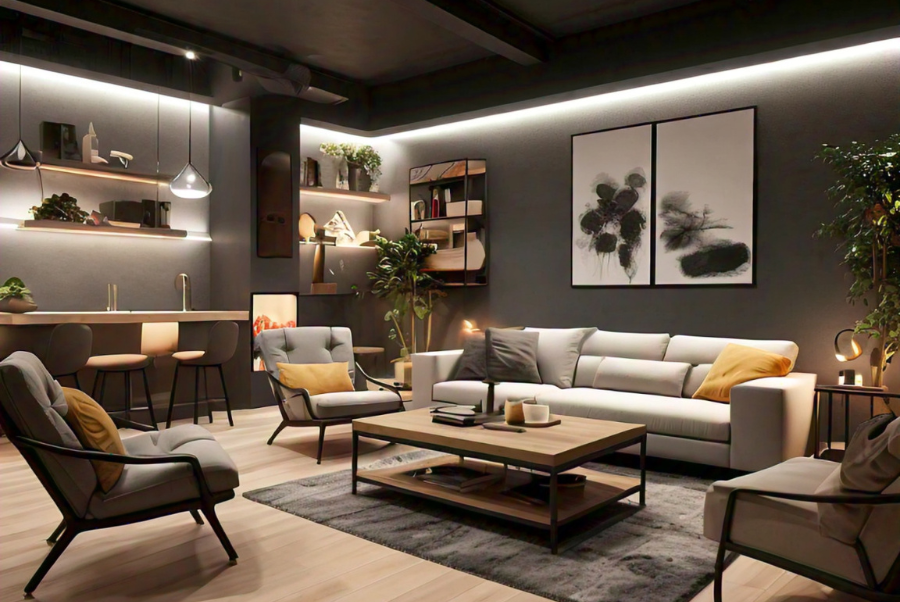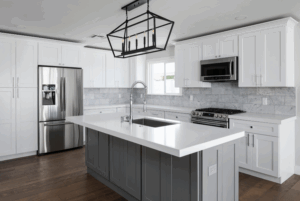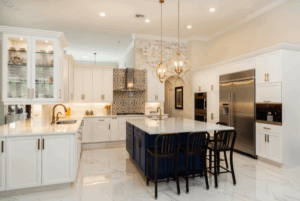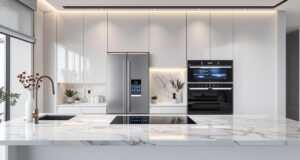As winter sets in, creating a comfortable and practical space in your basement can transform it into a sanctuary for relaxation, entertainment, or even work. A functional basement is more than just an extra room; it’s a warm, inviting area that maximizes the utility of your home. In this article, we’ll explore the five must-have features for a basement that keeps the cold at bay while offering unmatched functionality.
1. Insulation: The Foundation of a Cozy Basement
Why Insulation is Key:
Basements are notorious for being colder than the rest of the house. The underground structure exposes the space to chilly external temperatures, and without proper insulation, heat escapes quickly. A well-insulated basement ensures consistent warmth, reduces energy costs, and enhances comfort.
Types of Insulation Materials
Here are some effective insulation options:
| Material | Features |
|---|---|
| Spray Foam | High thermal resistance, seals gaps |
| Foam Board | Easy installation, moisture-resistant |
| Fiberglass Batt | Affordable, good for walls and ceilings |
Key Insulation Areas
- Walls: Install rigid foam boards or fiberglass batts.
- Floors: Add underlayment insulation or area rugs for extra warmth.
- Windows: Use thermal curtains or plastic insulation film to seal heat in.
2. Efficient Heating Solutions for Basement Comfort
Why Heating Matters:
A functional basement needs an efficient heating system to combat winter chills. Unlike upper levels, basements often retain cold air due to their below-ground construction and limited exposure to sunlight. Installing the right heating solution not only ensures warmth but also enhances the overall usability of the space, making it perfect for relaxation, work, or play.
Best Heating Options for Your Basement
- Radiant Floor Heating
- How It Works: This system heats the floor directly using electric coils or water-heated tubing.
- Benefits: Even heat distribution, energy efficiency, and a luxurious feel underfoot.
- Drawback: Higher installation cost compared to other methods.
- Tip: Pair radiant floor heating with insulated flooring for maximum efficiency.
- Mini-Split Heat Pumps
- How It Works: A ductless system provides both heating and cooling.
- Benefits: Easy to install, energy-efficient, and ideal for zoning (heating specific areas).
- Drawback: Initial costs can be higher than traditional space heaters.
- Space Heaters
- How It Works: Portable devices that use electricity to generate heat.
- Benefits: Affordable, portable, and easy to use.
- Drawback: Less energy-efficient for long-term use in larger spaces.
Pro Tips for Heating Optimization
- Combine Heating Solutions: Use radiant floor heating for a luxurious base and a space heater for targeted warmth in specific corners.
- Seal Air Leaks: Gaps around doors and windows let cold air seep in. Apply weatherstripping and caulk for better heat retention.
- Add Insulating Drapes: Thick, thermal curtains or shades trap heat while adding a decorative touch.
3. Moisture Management: Keeping Your Basement Dry and Functional
Why Moisture Control is Crucial:
A functional basement must be warm and dry to serve as a comfortable living space. Basements are naturally prone to moisture due to their location below ground level, where they’re exposed to water seepage and humidity. Without proper moisture management, your basement can develop mold, mildew, and unpleasant odors, rendering it unsuitable for use.
Steps to Ensure a Dry Basement
- Seal the Walls and Floors
- Waterproof Paint: Apply a waterproof sealant or specialized paint to your basement walls and floors. This creates a barrier against water infiltration.
- Epoxy Coatings: Use on floors to add durability and an extra layer of moisture protection.
- Pro Tip: Reapply waterproof paint every few years to maintain effectiveness.
- Invest in a Sump Pump
- A sump pump is essential for removing water that collects in your basement. Install one in areas prone to flooding or heavy rainfall.
- Advanced Tip: Consider a backup battery-powered sump pump to ensure functionality during power outages.
- Control Humidity with a Dehumidifier
- Dehumidifiers remove excess moisture from the air, maintaining a balanced humidity level. Aim for a relative humidity of 30-50% to prevent mold growth.
- Repair Foundation Cracks
- Even small cracks in your basement’s foundation can lead to water seepage. Patch these cracks with hydraulic cement or consult a professional for larger issues.
Signs of Moisture Problems
| Symptom | Cause | Solution |
|---|---|---|
| Damp Walls or Floors | Poor waterproofing | Apply sealants, install drainage systems |
| Musty Odors | Mold or mildew growth | Use dehumidifiers, clean with mold remover |
| Water Pooling | Drainage issues or foundation cracks | Install sump pump, fix cracks |
Advanced Moisture Solutions
- Install a French Drain: A French drain redirects water away from your foundation, reducing the risk of seepage.
- Add Vapor Barriers: Use plastic sheeting on walls and floors to block moisture penetration.
- Expert Insight: “Effective moisture management in basements not only prevents damage but also protects indoor air quality, ensuring your family’s health and safety.” – Home Renovation Specialist, Anna Rodriguez.
4. Multi-Purpose Design for Functionality
Why Multi-Purpose Design Matters:
To create a truly functional basement, it’s important to maximize its versatility. A multi-purpose design ensures your basement serves various needs, whether as an entertainment hub, home office, or guest suite. A thoughtfully designed basement not only adds value to your home but also enhances its utility throughout the year.
Key Design Ideas for a Functional Basement
- Home Office
- Benefits: Quiet, secluded area for remote work or studying.
- Design Tips:
- Include built-in desks and storage to optimize space.
- Add ergonomic furniture for comfort during long work hours.
- Ensure adequate lighting, including task and ambient lighting.
- Entertainment Zone
- Benefits: A perfect spot for family movie nights or game sessions.
- Design Tips:
- Install a projector or large-screen TV with surround sound.
- Add cozy seating like sectional sofas or bean bags.
- Use soundproofing materials to minimize noise in the rest of the house.
- Guest Suite
- Benefits: Offers privacy for visitors while utilizing underused space.
- Design Tips:
- Include an ensuite bathroom and kitchenette for convenience.
- Opt for fold-away or Murphy beds to save space.
- Add calming decor and warm lighting to create a welcoming atmosphere.
- Fitness Area
- Benefits: Convenient space for home workouts or yoga sessions.
- Design Tips:
- Use rubber flooring to protect equipment and reduce noise.
- Add mirrors to make the space feel larger and monitor your form.
- Incorporate shelving for weights, mats, and other gear.
- Children’s Playroom
- Benefits: A safe, designated space for kids to play during winter.
- Design Tips:
- Install soft flooring for safety, such as foam tiles.
- Use bright, cheerful colors and add ample toy storage.
- Include a reading nook or craft area for varied activities.
Pro Tips for Multi-Purpose Design Success
- Zoning: Use furniture, area rugs, or dividers to create distinct zones within the basement for different activities.
- Modular Furniture: Invest in pieces that can adapt to changing needs, such as foldable tables or sectional sofas.
- Storage Solutions: Optimize vertical space with wall-mounted shelves or under-stair storage.
5. Lighting and Ambiance for Winter Warmth
The Role of Lighting in a Functional Basement
Lighting can dramatically transform your basement from a dark, uninviting area into a warm and vibrant space. As basements often lack natural light, incorporating layered lighting and thoughtful design elements ensures both functionality and coziness. A well-lit basement creates a welcoming ambiance, enhances usability, and highlights your carefully curated design.
Types of Lighting to Consider
- Ambient Lighting
- Purpose: Provides overall illumination to the entire space.
- Options: Recessed ceiling lights, track lighting, or large overhead fixtures.
- Tip: Use warm-toned LED bulbs for a soft, inviting glow.
- Task Lighting
- Purpose: Lights specific areas for activities like reading, working, or cooking.
- Options: Desk lamps, under-cabinet lighting, or focused spotlights.
- Tip: Choose adjustable fixtures to direct light where you need it most.
- Accent Lighting
- Purpose: Highlights design elements such as artwork, shelving, or architectural features.
- Options: Wall sconces, LED strips, or uplights.
- Tip: Install dimmers to adjust the intensity for different moods.
Decorative Elements for Ambiance
- String Lights: Add charm and warmth to seating areas or play zones.
- Candles and Lanterns: Create a cozy, intimate vibe with flameless LED candles for safety.
- Mirrors: Strategically place mirrors to reflect light and make the space feel larger.
- Natural Elements: Incorporate plants, wood finishes, and textured fabrics to add a sense of warmth and comfort.
Pro Tips for Perfect Basement Lighting
- Layer Your Lighting: Combine ambient, task, and accent lighting to cater to different activities and moods.
- Choose Fixtures Strategically: For low ceilings, opt for flush-mount or recessed lighting to avoid clutter.
- Emphasize Warmth: Stick to color temperatures between 2700K-3000K for a cozy, winter-ready environment.
Bonus Tips for a Functional Basement Makeover
Transforming your basement into a truly functional space requires attention to details that go beyond the basics. Below, we expand on the bonus tips to help you achieve a polished and versatile space.
1. Soundproof for Privacy and Comfort
A soundproofed basement is ideal if you’re planning to use it as a home theater, music studio, or workspace. Materials like acoustic panels, insulation batts, or sound-dampening drywall can significantly reduce noise transfer.
Pro Tip: Add rugs, thick curtains, and upholstered furniture for additional sound absorption. These elements enhance both function and aesthetics.
2. Custom Storage to Maximize Space
A functional basement thrives on smart storage. Opt for built-ins that blend seamlessly into the walls for a clean look. Incorporate hidden storage under stairs or within seating areas to maintain a clutter-free environment.
Example: A basement used as a family game room was transformed with custom cabinetry to store board games, electronics, and even seasonal decor.
3. Open-Concept Layout for Versatility
An open floor plan can make your basement feel more spacious while allowing flexibility for multiple functions. Use area rugs or partial dividers like bookcases to define zones without closing off the space.
Design Tip: Arrange furniture in clusters to create functional zones, such as a reading corner, entertainment area, or play zone.
4. Ventilation: Fresh Air for a Healthier Space
Basements often struggle with stale air or odors. Improve ventilation with options like an energy-recovery ventilator (ERV) or inline exhaust fans. If you’re finishing a basement, consider incorporating vents into the HVAC system.
Data Insight: A well-ventilated space reduces humidity, lowering the risk of mold growth and improving indoor air quality.
5. Durable, Stylish Flooring
Choose flooring that withstands the unique conditions of basements. Materials like luxury vinyl planks or treated concrete are excellent choices due to their moisture resistance. For added warmth, layer area rugs in key areas like seating or play zones.
| Flooring Material | Benefits | Drawbacks |
|---|---|---|
| Luxury Vinyl Planks | Durable, waterproof, and stylish | Can feel cold without rugs |
| Engineered Hardwood | Warmer and elegant | Prone to moisture damage |
| Treated Concrete | Affordable and customizable | Requires sealing |
6. Add a Wet Bar or Kitchenette
Elevate your basement’s functionality by incorporating a wet bar or mini kitchen. This addition is perfect for entertaining or creating a self-contained guest suite. Include essentials like a small fridge, microwave, and sink for convenience.
7. Warm Color Palette for a Cozy Feel
Decorating with warm, neutral tones enhances the comfort and livability of a basement. Soft yellows, beiges, and earth tones create a cozy environment. Complement with bold accent pieces like patterned throw pillows or rugs.
Design Tip: If your basement is small, use lighter tones to make the space feel brighter and more open.
8. Install a Fireplace for Warmth and Style
An electric or gas fireplace can become the centerpiece of your basement. Fireplaces not only add literal warmth but also create a visual focal point that enhances the space’s ambiance.
Modern Option: Wall-mounted electric fireplaces save space and offer customizable flame effects for added aesthetics.
9. Meet Safety Requirements with Emergency Exits
Ensure your basement meets local building codes by installing egress windows or a dedicated exit. This is crucial for safety, especially if the basement includes sleeping quarters.
Fact: Egress windows must meet specific size and accessibility requirements to comply with safety standards.
10. Embrace Smart Technology for Convenience
Smart technology enhances your basement’s functionality. Use smart thermostats, lighting systems, or voice-controlled assistants to streamline your day-to-day activities. For security, add smart cameras or motion sensors.
FAQs About Functional Basement Upgrades
- Why invest in a functional basement?
A functional basement adds living space, boosts home value, and offers flexibility for uses like entertainment, work, or guest accommodations. - How do I prevent moisture and mold?
Waterproof walls and floors, use a sump pump, and maintain proper drainage to keep your basement dry. - What are the best flooring options?
Durable, moisture-resistant options like luxury vinyl planks, tiles, or treated concrete work best. - Can my basement be comfortable year-round?
Yes, with insulation, proper heating, and ventilation, your basement can be cozy in any season. - Are permits required for basement renovations?
Most renovations require permits, especially if structural, electrical, or plumbing work is involved. Check local codes. - How much does a basement remodel cost?
Costs range from $10,000 for basic upgrades to $50,000+ for high-end features, depending on the scope. - How can I make my basement feel less like a basement?
Bright lighting, warm colors, and natural materials can create a welcoming atmosphere. - What’s the best way to zone a basement?
Use furniture, rugs, and lighting to create distinct areas for lounging, working, or entertainment. - How do I start my basement makeover?
Assess your space, plan features, set a budget, and consult professionals for a smooth renovation process.
Conclusion: Create the Functional Basement of Your Dreams
Transforming your basement into a functional and warm winter haven is more than a practical upgrade—it’s a lifestyle enhancement. By prioritizing insulation, effective heating, moisture control, multi-purpose layouts, and strategic lighting, you can create a space that’s both cozy and highly usable. Adding smart storage solutions, soundproofing, and thoughtful design touches ensures your basement is not only efficient but also stylish and welcoming.
As you embark on your basement renovation, focus on the key elements discussed and personalize the space to reflect your family’s needs and personality. A functional basement offers endless possibilities, whether it’s for hosting, working, relaxing, or simply enjoying winter in comfort.
Reach Out Today to Transform Your Basement
Investing in your basement is an investment in your home’s value and your quality of life. Let us help you bring your vision to life with tailored solutions that fit your style and budget. Reach out today to schedule a consultation and take the first step toward creating the functional basement of your dreams.









